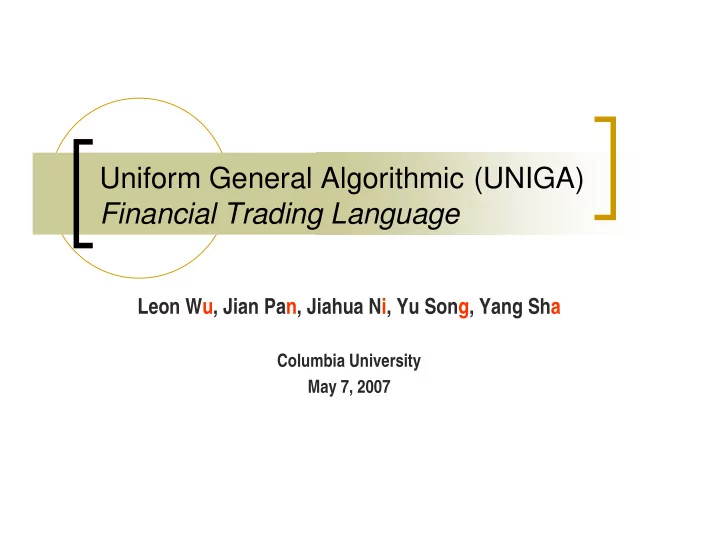

Uniform General Algorithmic (UNIGA) Financial Trading Language Leon Wu, Jian Pan, Jiahua Ni, Yu Song, Yang Sha Columbia University May 7, 2007
Outline of Presentation � Overview of language � Language tutorial and examples � Architectural design and implementation � Summary and lessons learned
Overview of Language � UNIGA: high level scripting language for financial trading. � Language Features: � Easy-to-use: simple syntax � Portable: platform-independent � Versatile: built-in functions � Powerful: complete trading workflow � Extendable: custom functions
Outline of Presentation � Overview of language � Language tutorial and examples � Architectural design and implementation � Summary and lessons learned
Language Tutorial and Examples � “Hello World” � Variables � Loops � “if” statement � User defined functions � Send an order � Check the price � Check the portfolio
“ Hello world” main(){ print "the market price for Microsoft is $"; double r=market "MSFT"; println r; } $ java Main market.uniga the market price for Microsoft is $30.56
Variables � Data type: “double” � Strings are primitive � Dates are translated via “date[]” main(){ double d1=date[20070404]; double d2=date[20070330]; print "The number of days between is:"; println d1-d2; } The number of days between is:5.0
Loops � “while” and “for” main(){ double r=0; while(r<2){ println r; r=r+1; } for(r=0;r<2;r=r+1){ println r; } }
“if” statement main(){ double a=1, b=2; if a<b then{ return 1; } else { return 0; } }
User defined functions � User can define their own functions � Pass by value double increase(double r){ return r+1; } void display(double r){ println r; return; } main(){ display(increase(3)); }
Send an order � “buy” / “sell” main(){ buy "MSFT" 1000 0 0; sell "INTC" 535 22.53 22.53; } Symbol ID number of shares stop price limit price
Send an order (cont’d) � An order may be filled, or discarded
Send an order (cont’d) � Portfolio is also changed
Check the price � “high”, “low”, “open”, “close”, “volume”, “market” main(){ double op=open "MSFT" {1}; double cl=close "MSFT" {2}; double cu = market "MSFT"; if op>cl then println cu; }
Check the portfolio � “ sum”– the sum of portfolio � “pl”– the profit loss � “holdings” – list the current positions main(){ double pfLoss=pl(); double assetSum = sum(); holdings; }
Outline of Presentation � Overview of language � Language tutorial and examples � Architectural design and implementation � Summary and lessons learned
Architectural Design and Implementation
Data Structure Diagram
Trading Process and Data Flow buy "MSFT" 1000 0 30.50; Orders(int type, String stockID, double amount, double stopPrice, double limitPrice) Update order (ORDERS.xml): add the order entry stopPrice > ? limitPrice > ? if stopPrice>0 && if stopPrice==0 && if stopPrice>0 && if stopPrice==0 && limitPrice>0 limitPrice==0 limitPrice==0 limitPrice>0 it is Stop Limit Order it is Market Order it is Stop Order it is Limit Order No No No low<limitPrice<high low<stopPrice<high low<limitPrice<high End low<stopPrice<high Yes Yes Yes filledStatus = 1 filledStatus = 1 filledStatus = 1 filledStatus = 1 filledPrice = marketPrice filledPrice = stopPrice filledPrice = marketPrice filledPrice = limitPrice or stopPrice filledQuantity = amount filledQuantity = amount filledQuantity = amount filledQuantity = amount Update portfolio (PORTFOLIO.xml): 1> increase/decrease cash; 2> add/update stock holding End
File System Structure / / /data /test ParserLexer.g —Built-in Functions— ORDERS.xml add.uniga Walker.g Stock.java PORTFOLIO.xml assign.uniga Makefile GetRealData.java average.uniga Main.java Orders.java /data/market builtinfunc.uniga Portfolio.java ACN.xml buy.uniga —Utilities Functions— ADBE.xml data.uniga ActivationRecord.java —Automated Testing— CSCO.xml division.uniga CommonASTWithLines.java uniga.pl DELL.xml ...... Date.java unit_test.pm EDS.xml stategy_1.uniga ErrorException.java bad_test_result.log HPQ.xml while.uniga FuncScope.java sound_test_result.log IBM.xml whileandopen.uniga Scope.java INTC.xml whileandsell.uniga (total 37 *.uniga files)
Lexer � Defining the set of most basic tokens to be recognized by UNIGA language. � Ex. +, -, *, /, (), [ ],{ }, ==, <, >, &, “,”
Parser � analyzes a sequence of tokens to determine its grammatical structure with respect to UNIGA grammar � Left associative � Data Type: double � Statements: for, while, if-else, buy, sell � Expression: open, close, high, low, volume, date � Declaration: variable, function
Walker � Walker parses the AST and associates actions with each syntax � Scope definition � Operation definition
Testing � Unit Testing, Regression Testing and Automated Testing � Unit testing for every language construct to eliminate error at early stage � Prepare a set of test cases, and pass all of them before uploading codes to SVN � Deploy regression testing when a milestone is met
Outline of Presentation � Overview of language � Language tutorial and examples � Architectural design and implementation � Summary and lessons learned
Summary and lessons learned Team work and effective project management � Set up development milestones � Ensure on-time deliverables by regular meetings at the � start of every week, constant email contacts during the week Ensure team members’ understanding of weekly goal � before workload breakdown. Start with a small core objective and apply incremental � approach in development. SVN (Subversion) on CUNIX � Source control a must for large scale team development � effort
Incremental Development Approach � Select a good application scope for the language � Build a small core in the start, anticipate more time spent than expected at this stage � Modularized development, separate the project into front-end and back-end � Regression testing implemented to guarantee new features won’t break old features
Be Ready for Disasters Recovery � You never know a single operation can cause catastrophe. � We lost some files due to a careless operation � Periodically back up
Thank You! � UNIGA Team � Columbia University � May 7, 2007
Recommend
More recommend